Ai Weiwei, Jing Kewen, Li Songsong, Liu Jianhua, Mao Tongqiang, Song Dong, Xiang Jing, Xu Bing, Yin Xiuzhen, Yue Minjun
4.10.12-3.2.13
Bergen Art Museum
Highlights from Chinese contemporary art shown in Bergen
The contemporary art scene in China is incredibly large and interesting, you could spend days and weeks just running through all the important galleries in the numerous art districts like 798 or Caochangdi in Beijing or Mogashan Lu in Shanghai. Now this is made so much easier by Bergen Art Museum and their collaborators.
This autumn you just have to travel to Bergen to see the top level of Chinese contemporary artist, with exhibitions of their work and an extensive programme of presenting the art and the Chinese contemporary art scene. The most profiled artist and work is the world premiere on the work of 81 wooden balls by Ai Weiwei in the Lysverket building of Bergen Art Museum. Add a group of artists that are almost as famous and important, together with a group of young aspiring artists, and the picture is complete.This is far from showing a complete view of the art scene, but what you get is some of the most important artists and art trends.
The main attraction is the "Real Life Stories" exhibition in Bergen Art Museum. In addition to this there are more collaborating galleries with Chinese contemporary art in town.I had the pleasure of experiencing the exhibition “Real Life Stories” at Bergen Art Museum, “Skin, Flesh, Bone” at Stiftelsen 3,14, and Song Kun and Jin Nv at Galleri SE. They deserve one post each. This is about "Real Life Stories":
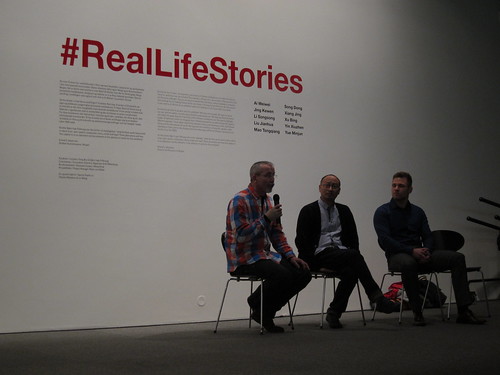
Curators' introduction by Bjørn Inge Follevaag and Feng Boyi
Due to its vast size, the exhibition is divided on two of the museum's buildings. The work by Ai Weiwei and the largest sculpture by Xiang Jing are in the Lysverket building, while the rest of the works are in the large exhibition halls of the Stenersen building.
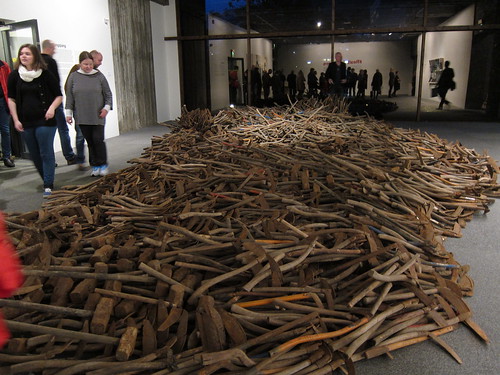
Mao Tongqiang: Tools
The first work that greets you in the Stenersen building is the gigantic heap of workers' tools by Mao Tongqiang. All in all he collected 30.000 hammers and sicles, "only" 5.000 are displayed here. These are tools that has been in use by Chinese workers and farmers. Joined together and guilded on a red background the hammer and sickle make the Communist flag. But there are no gold on these tools, only dirt and sweat from the people and the soil. As Westerners we would like to see this as a comment to communism, showing that it is not the symbolic golden. But it might also well as much be a tribute to the massive amount of farmers and workers all over the world that do their daily toll, and do not really care which rule they live under, as long as they get their harvest or paycheck.

Li Songsong: Oxygen Mask
An image as simple and explaining as the oxygen mask info on the flight security card. But there is more depth to it, both virtually and literally. The image is carved into a more than 10cm thick layer of paint. It took 7 months for the surface to dry, and it will take years for the core to dry. The time involved is important.
The painter has visualized his guess of what the rear side of the scene will look like. Just as we get curious of not only what the surface looked like before he started carving, but also what is underneath the surface. Even the colour rectangles are reversed on the reversed scene, and it is actually on the reverse scene the original colors are most visible. Sometimes we need to see something from a different angle to know the background. And we need do dig to see what is underneath the surface.
As to the scene, I have always found this instruction intriguing. It is totally reasonable, but it goes against all morality teaching. Help yourself before you help others. It sounds quite egoistic, doesn't it? But if you need to be capable before you can help others, so it makes perfectly sense. This is about knowing your weaknesses, and by making yourself strong you can use that strength to give to others.

Li Songsong: Fifteen
Songsong uses his technique of thick paint layers also in this work, being an archaeologist in the canvas. Portrayed are the fifteen participants of the founding of the Chinese Communist Party. The portraits must be known to every Chinese, but for us they are unfamiliar faces. Would it have changed something if we also knew who they are, or are they left to fade away? What parts of our history do we keep in our memory and what parts do we intentionally forget?
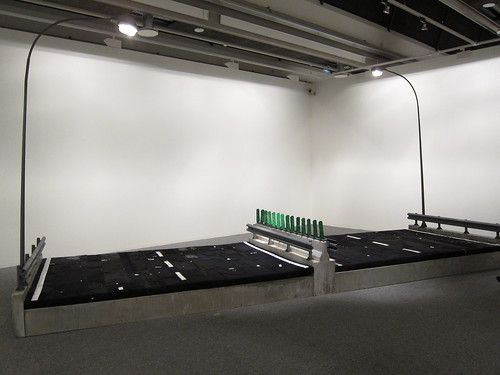
Yin Xiuzhen: Highway
China is spending incredible amounts on their infrastructure. A web of highways are connecting the most faraway spots to the centres. You may find these massive highways passing close by the most remote towns, where the locals still travel on horseback. The highways provide possibility for the remote to travel to the center, but it also allows the center to get control of the remote. In short, highways offer connections. But they are also barriers, massive intrusions in beautiful landscape, difficult to cross by men and animals.
There is something smooth and wonderful about asfalt, but it is also unnatural and inhuman. This highway, however, is made by fabric. The artist has made a collage of clothes, fit together to look exactly like a four-lane highway. This is not hard asfalt for travelling fast, but a soft surface you can relax comfortably on. Instead of speeding up we should slow down.
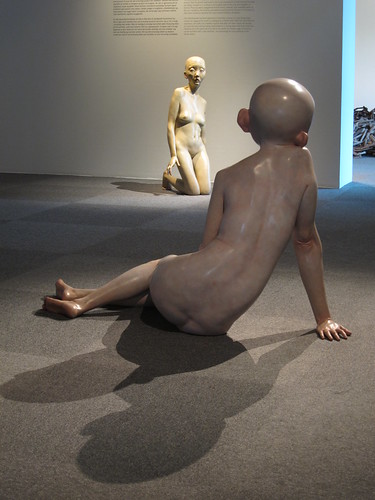
Xiang Jing: Peacocks
Two nude female figures are sitting opposite each other. They both have a sad expression on their faces, and one of them has a unnatural large head. It has the body of a woman and the head of a child. They may seem like individual sculptures, but the tension is between the sculptures. They are portrayed with a strong beauty, and at the same time strong fragility. Who is the adult, who is looking after who?
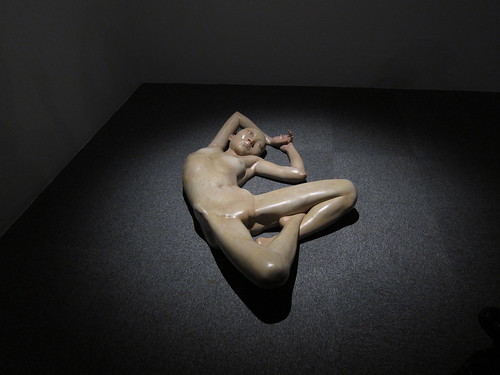
Xiang Jing: I Am 22 Years Old, But without My Period
The most descriptive and also the most secretive title of the exhibition. The straightforwardness of the title and the sculpture is uncomfortable. There is a story here that we would prefer kept as a secret. The very personal is forced upon us, knowing that she is suffering, not we. Is this a metaphor for somehing - growing up, being a woman, the developments in China?
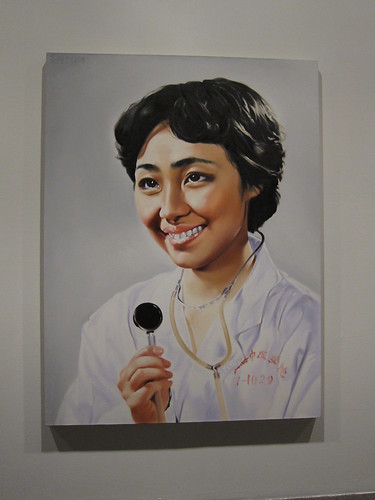
Jing Kewen: Cloudless 2009 No.1
Four large paintings are presented by Jing Kewen. These are large scale reproductions of found miniature pictures. Not even the artist knows the background of these exact photos, only that they were produced in the 1950s and 1960s. There is a story behind every picture, but we must make it ourselves. One explanation is that these are propaganda pictures showing the wonderful life during the Cultural Revolution, and that the reproduction in large scale is making fun of or being satirical on the difference between reality and the propaganda. But another approach may be that this shows that life was liveable also during those times. During any kind of rule there will be some moments of joy, of friendship, of excitement and of beauty.
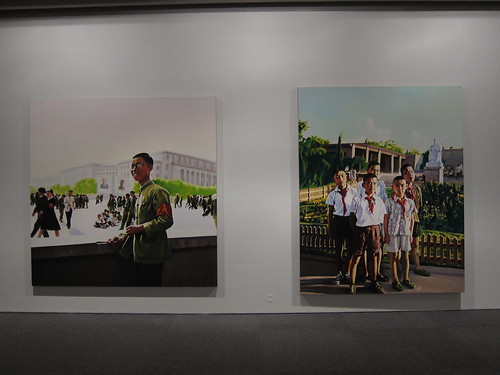
Jing Kewen: Cloudless 2009 No.3 + Mr. Lu Xun

Jing Kewen: Dream 2008
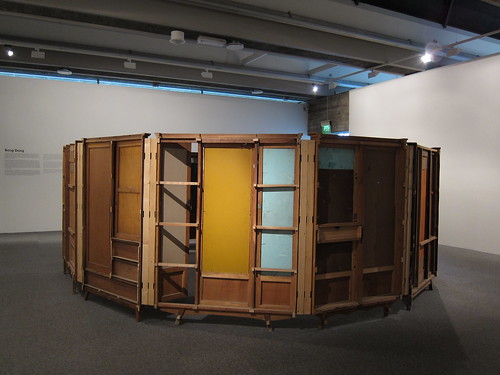
Song Dong: Wisdom of the Poor: Enclosure Movement
These wardrobe closets used to be in every Chinese home. Or rather, it was a dream of every home to have one. This was where all the valuables were stored, this was the archive of the family. As central districts are torn down to make way for larger residential buildings, people are moving to apartments in the suburbs. They are uprooted, their history is lost. These closets do not fit into the new apartment, and are replaced by shiny plastic furniture. The valuables inside it may be the same, but the container, the context has changed.
You can actually enter through some of the doors, facing all the exteriors of the closets. You are outside the wardrobes, while the rest of the world is inside the closets. The wardrobe closets contain the world.
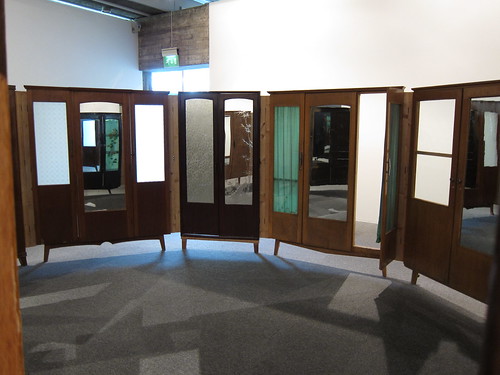
Song Dong: Wisdom of the Poor: Enclosure Movement
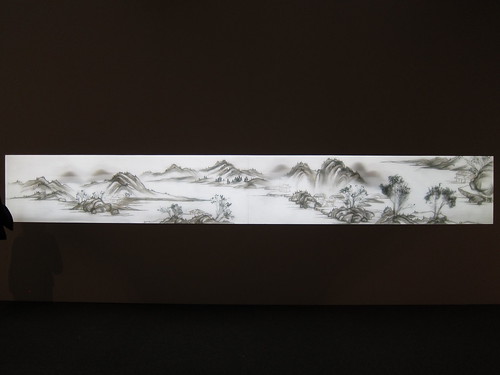
Xu Bing: Background Story
Xu Bing uses material found on the spot for these works, this in number seven in this serie. Even Bergen Musem has a collection of Chinese artefacts. How they got there is probably a long story, but the core is that Chinese ancient culture is found everywhere. Bing found this scroll painting, and made his own version. From the front side it seems like a rice paper drawing with backlight. But as you go round to the back side, you discover that this is not a drawing, but a collage of found material and rubbish. The picture was not what it seemed. Exactly like the original, which turned out not to be the ancient treasure, but a newer copy.
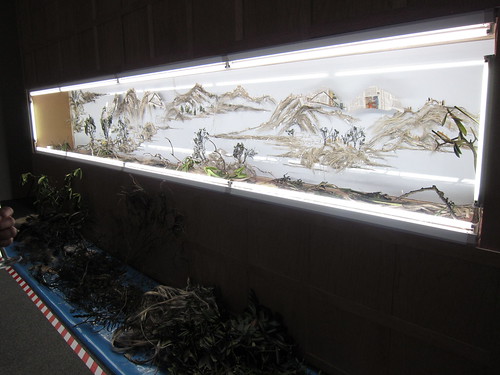
Xu Bing: Background Story
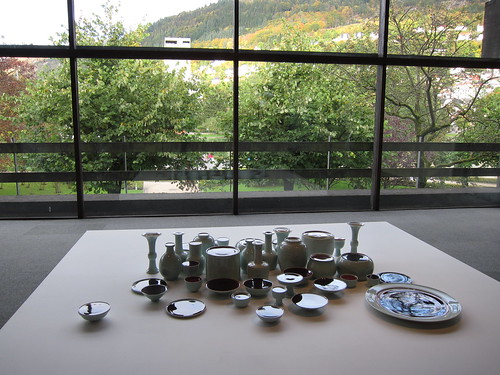
Li Jianhua: Horizon
Copies of ancient porcelain. But while the ancient vessels were both for decoration and for storing, these are unable to store anything. They are already filled up with a red substance. What it is we will not know. And what is underneath the surface we will also not know. They all make a surface parallell to the horizon, as the title suggests. Even the porcelain bone on the wall is horisontal.
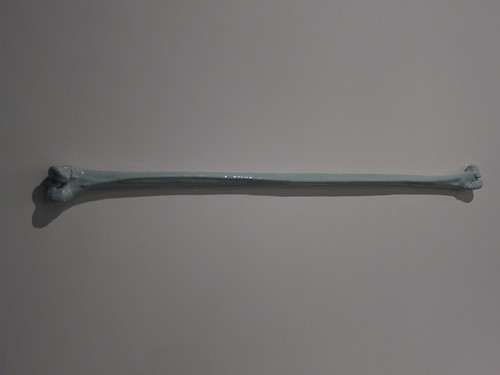
Li Jianhua: Horizon
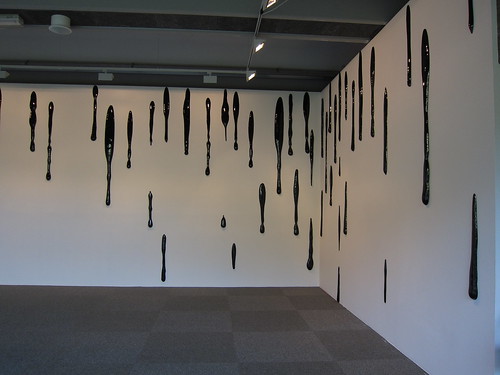
Li Jianhua: Traces
The artist also presents large black drops in porcelain. Like the leftovers of some large calligraphic works, or some kind of disintegrating spots.

Yue Minjun: Untitled
The painting by Yue Minjun is strangely hidden on the gallery of the exhibition halls. It is easy to miss it when you are at the exhbition, but as the leaves start falling from the trees outside, it will be the most visible from the outside park. Minjun's extremely happy selfportraits are here as in all his work, this time clad in chinese art. Their over-happiness is creepy, and makes me wonder if they really are happy or just faking it. Still, it is difficult not getting in a good mood looking at them.
* * *
Two of the works were too large to fit in to the Stenersen exhibition space. They are really fitting well into the space of the great Lysverket building, a former office building for the electricity company.
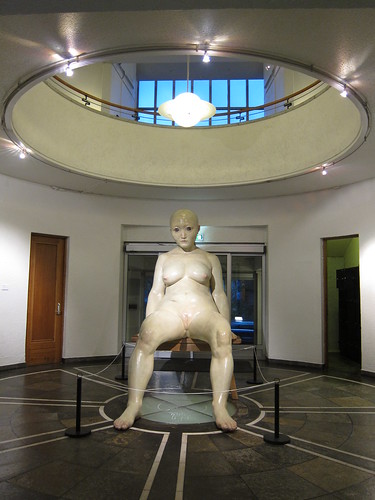
Xiang Jing: Your Body
Jing's sculpture is straight in your face as you enter the staircase room for going up to Ai Weiwei's work. It is impossible not to notice the female figure, due to the immense size, her nakedness, and the fact that she is demanding most of the space. She seems so intensely sad, making you feel sorry for her, not knowing why. Of course it must be annoying sitting there naked with all the people passing by, but it seems to be something far beyond that which bothers her.
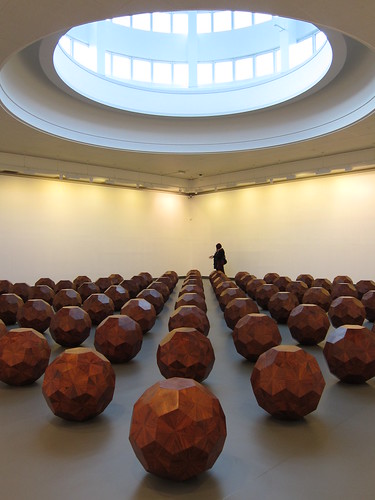
Ai Weiwei: 81 Wooden Balls
And the the main draw of the exhibition, in the best space of the art museum: the 81 wooden balls by Ai Weiwei. We were all waiting in line to be among the first in the world to see the installation, putting on protection socks and going in in limited groups.
Each ball is made of the most precious wood, consisting of a lot of small units fit together by a technique developed by the artist through many years. This is like the childhood puzzle that was almost impossible to solve, only that this puzzle can never be taken apart again. It is fitted to stay together for good. The 81 balls are put in a perfect setting, perfectly in line and in angle to each other in 9x9 formation.
At first I am slightly disappointed. It is like I expect Ai Weiwei to always make something political. Maybe there are some political aspect to this too, or maybe there is just because we want it to be. But then it strikes me how wonderful the shapes, the technique and the arrangement is. Does art always need to be political? Or can it be "just" beautiful, and enigmatic? In this work Ai Weiwei fortunately does not give any answers. He leaves us puzzled and amazed.
* * *
We all have our ideas of what China is, and especially how we want China to be. And it seems we crave to see this in the art too. We expect Chinese art to look like European art, we want that the Chinese artists express a wish to change China into European. Are we looking at European art the same way, and are others looking at "our" art that way? Does Chinese look at Norwegian contemporary art, expecting all to be attacking our oil based economy or our massive consume? Or are they expecting works about polar bears, midnight sun and Edvard Munch? Why don't we put away our "made in China" perception, and just look at the artworks as art?
This exhibition shows art that is interesting and important, not because it is Chinese, but because it simply is great art.
More Ai Weiwei here
More Chinese art here